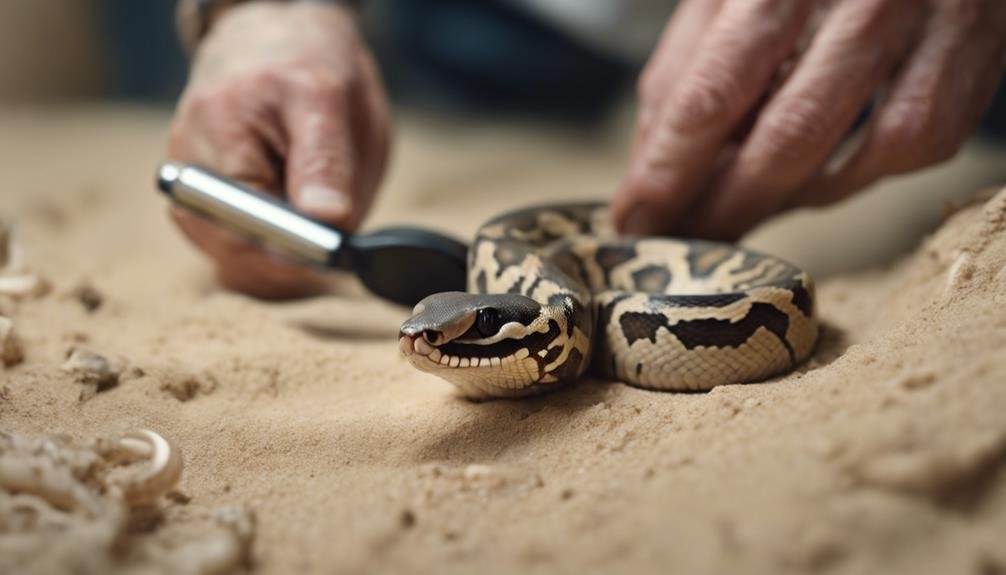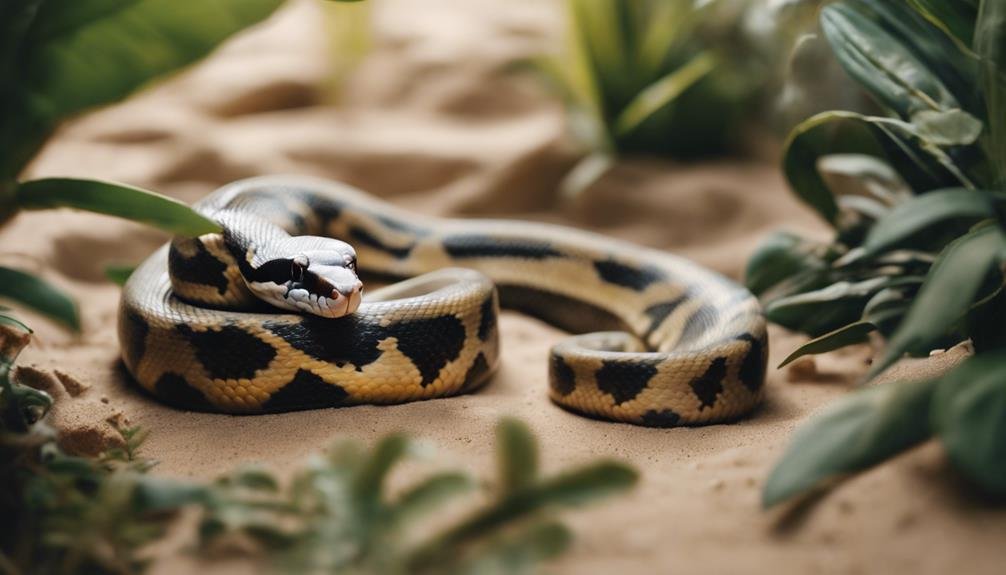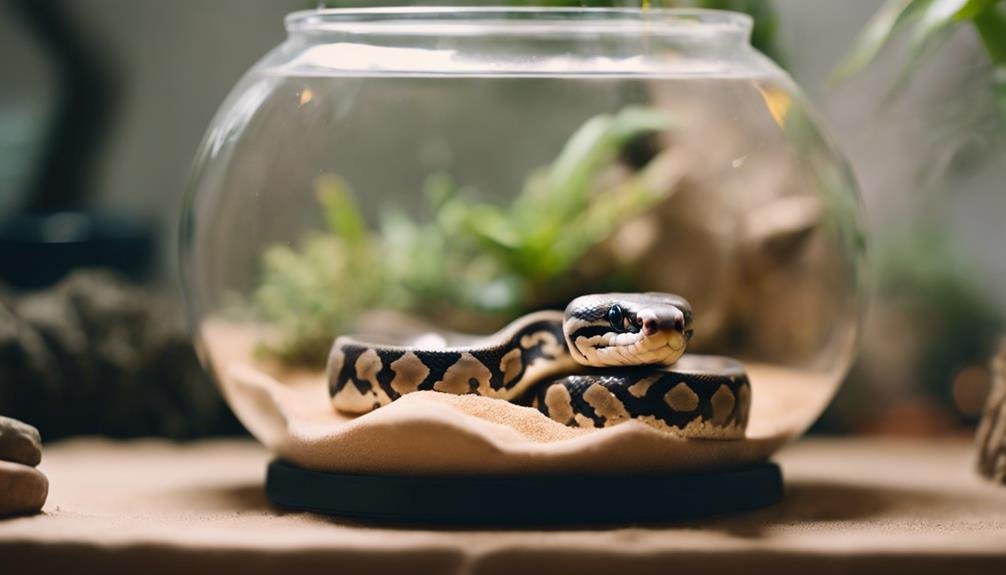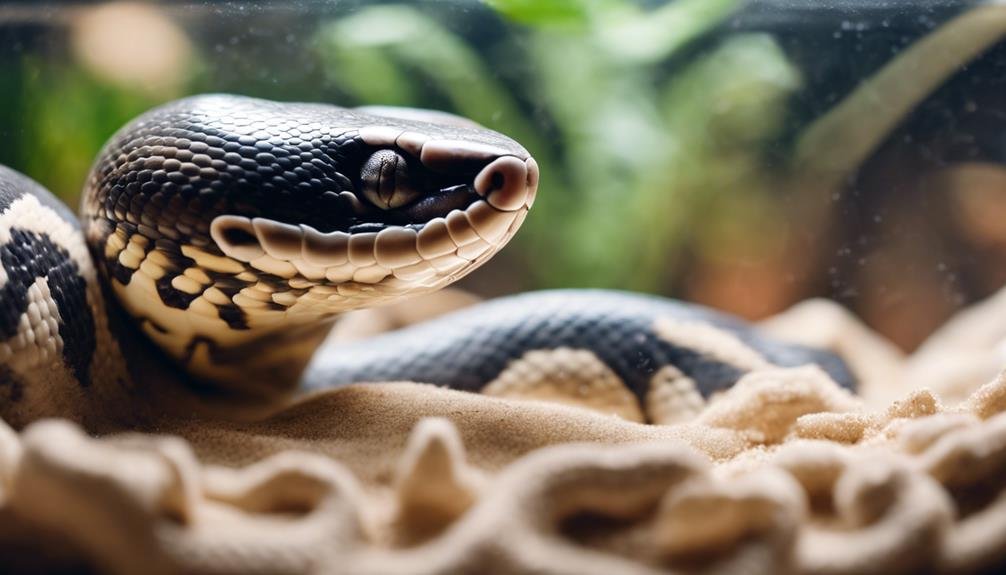You might think that transforming your ball python‘s enclosure into a mini-desert with sand would make for a picturesque habitat, but this common misconception could endanger your pet’s health. Sand, while aesthetically pleasing, poses serious risks like respiratory problems, impaction, and skin irritation. Before you decide on your snake’s substrate, consider the underlying hazards of sand and why experts strongly advise against it. Let’s explore the safer alternatives that not only mimic their natural environment but also safeguard their longevity and health. Curious about what makes these options better? Stick around to uncover the vital details that could save your snake from unnecessary distress.
Key Takeaways
- Ball pythons do not thrive on sand due to the risk of digestive blockages from sand impaction.
- Sand’s abrasive nature can harm a ball python’s skin and eyes, leading to irritation and infections.
- Inhaling sand particles can cause serious respiratory problems, including infections that could be fatal.
- Sand is not reflective of a ball python’s natural habitat, which includes grasslands and forests, not sandy environments.
- Safer substrate alternatives like aspen shavings, cypress mulch, or reptile carpet are recommended to prevent health issues.
The Risks of Using Sand
While sand may seem like a natural choice for ball python habitats, it poses significant risks to their health and well-being. One of the most serious concerns is sand impaction. This occurs when your ball python accidentally ingests sand while feeding, which can lead to a digestive blockage. This blockage prevents them from properly digesting their food, and without prompt veterinary care, it can be fatal.
Beyond the risk of impaction, sand can also be abrasive to your snake’s skin and eyes. This irritation can cause discomfort and may even result in injuries if your ball python tries to relieve the irritation by rubbing against objects in its enclosure. In addition, despite the potential overlap with respiratory issues, it’s important to note that a sandy environment can become quite dusty. This dust isn’t just a nuisance; it can lead to respiratory problems by irritating your snake’s lungs if inhaled over time.
Given these risks, it’s clear that sand isn’t a safe substrate choice for ball pythons. Instead, you’re better off opting for safer alternatives, such as paper towels or reptile carpet, that won’t pose a threat to your snake’s health.
Respiratory Issues Explained
Understanding the risks, it’s vital to recognize how sand can greatly harm your ball python’s respiratory health. When you choose sand as a substrate, you’re unknowingly introducing your pet to a world of potential respiratory issues. The fine particles of sand can easily become airborne, especially during your snake’s regular activities like exploring or burrowing. Once inhaled, these particles can irritate their respiratory system, leading to serious infections such as pneumonia. This isn’t something to take lightly, as respiratory infections can be fatal for ball pythons.
The dusty environment created by sand substrate exacerbates these risks, making it even more likely for your snake to suffer from respiratory problems. It’s not just about the immediate effects; the long-term health of your ball python is at stake. To protect them, avoiding sand as a substrate is crucial. Instead, opt for safer alternatives like paper towels, aspen shavings, or coconut husk. These options will help you prevent respiratory issues in your ball python, ensuring they remain healthy and happy in their habitat.
Impaction Hazards


Beyond respiratory issues, sand poses a significant risk of impaction for ball pythons, which can lead to severe digestive blockages and health complications. When your ball python ingests sand, either accidentally while feeding or out of curiosity, it can clog their digestive system. Unlike in their natural habitat, where sand isn’t a primary substrate, in captivity, the use of sand increases the risk of these health issues substantially.
Sand impaction can cause discomfort, pain, and in severe cases, it might be fatal. To prevent such dire outcomes, it’s essential to opt for safer substrate alternatives that mimic the natural environment of ball pythons without the associated risks.
| Substrate | Risk of Impaction |
|---|---|
| Sand | High |
| Aspen Shavings | Low |
| Paper Towels | Very Low |
| Reptile Carpet | Very Low |
This table highlights the importance of choosing the right substrate for your ball python. Aspen shavings, paper towels, and reptile carpet are much safer alternatives that significantly reduce the risk of sand impaction. Regularly monitoring and maintaining the substrate will also help in keeping your ball python healthy and impaction-free.
Skin Irritation Concerns
When it comes to your ball python, you mightn’t realize that sand in their enclosure can cause more harm than good.
The rough texture of sand can irritate their skin, leading to cuts and possible infections.
You’ll need to look into safer substrate options and maintain a clean living space to prevent these issues.
Causes of Skin Irritation
Ball python’s skin can become irritated by sand’s abrasive texture, leading to discomfort and potential health issues. When you use sand as a substrate for your ball python, you’re exposing them to an environment that can scratch and damage their delicate scales.
This isn’t just about minor skin irritation; it can escalate into stress and more severe injuries over time. Additionally, sand’s knack for absorbing moisture can dry out your snake’s skin, making the irritation worse.
It’s also worrisome when ball pythons ingest sand accidentally while exploring or feeding, as this can lead to digestive problems and impaction. These factors combined make sand a less-than-ideal choice for your ball python’s habitat, urging a switch to safer substrate options.
Preventing Irritated Scales
Recognizing the risks sand poses to your ball python’s skin, it’s important to explore effective strategies for preventing scale irritation.
Sand’s abrasive texture can lead to skin irritation, including redness and raw spots, making it tough for your snake to move and shed properly. This discomfort can escalate to more serious health issues if not promptly addressed.
Fine particles of sand can get trapped in the scales, further irritating the skin and potentially causing infections. To safeguard your ball python’s health, opt for substrates like paper towels, reptile carpet, or coconut husk bedding. These alternatives can help prevent skin irritation and promote overall well-being.
Regularly checking your snake’s skin and behavior helps catch any signs of discomfort early, enabling timely intervention to prevent further issues.
Safer Substrate Alternatives


When considering your ball python’s home, it’s essential you choose the right substrate to avoid health issues like respiratory problems and impaction. Options like aspen shavings, cypress mulch, and reptile carpet not only provide a safer environment but also cater to your snake’s burrowing instincts.
Ideal Substrate Choices
To guarantee your ball python’s safety and comfort, consider using safer substrate alternatives like aspen shavings, cypress mulch, coconut husk, or paper towels. These options not only mimic your snake’s natural habitat but also steer clear of the risks tied to sand.
Aspen shavings stand out for their affordability, ease of cleaning, and their knack for holding just the right amount of humidity. Meanwhile, cypress mulch brings a slice of the natural world into your pet’s enclosure, boasting excellent humidity retention and a resistance to mold and mildew that’s hard to beat.
If you’re looking for a temporary fix, paper towels can be a safe bet, offering simplicity in cleaning and frequent replacement without compromising your snake’s well-being.
Avoiding Common Mistakes
After exploring ideal substrate choices for your ball python, it’s equally important to steer clear of common mistakes by opting for safer alternatives.
Sand impaction can lead to serious health problems, even death, if your snake ingests it. To prevent such risks, consider using aspen shavings, cypress mulch, paper towels, or coconut husk instead. These safer substrate alternatives are less likely to be ingested, making them easier to clean and maintain.
Understanding Snake Comfort
Providing your ball python with the appropriate substrate is essential for its comfort and health. Understanding snake comfort starts with recognizing the negative impacts of unsuitable substrates like sand. Sand isn’t just unpleasant for your snake; it poses real risks. It can cause respiratory issues if your ball python inhales it, a common problem that’s easily avoidable with the right bedding. Beyond breathing problems, sand can irritate their eyes and lead to skin abrasions, making their overall environment uncomfortable and harmful.
Remember, ball pythons don’t come from sandy deserts. Their natural habitat consists of grasslands and forests, environments you should aim to mimic in their enclosure. By choosing substrates such as aspen shavings or coconut husk, you’re not only preventing respiratory issues and physical harm but also creating a space that feels like home to them. This adherence to recreating their natural habitat plays an important role in their well-being.
Ensuring a comfortable and safe environment for your ball python is key to its happiness. It’s about more than just avoiding the wrong substrate; it’s about understanding and catering to their needs, which in turn will contribute significantly to their overall well-being.
Preventing Health Problems


Selecting the right substrate for your ball python is essential in preventing health issues like respiratory problems and impaction. Sand, while it might seem like a natural choice, can actually do more harm than good. The fine particles can create dust when disturbed, leading to respiratory issues. Even more concerning, if your snake ingests sand, it can lead to impaction, a serious health problem that can be difficult to treat.
Here’s why you should think twice about using sand as a substrate for your ball python:
- Respiratory Issues: The dust from sand can lead to respiratory problems, making it hard for your snake to breathe.
- Impaction Risk: Ingesting sand can cause impaction, a blockage in the intestines, which is a serious, sometimes fatal, health issue.
- Skin and Eye Irritation: Sand can irritate your ball python’s skin and eyes, leading to discomfort and potential infections.
- Breeding Ground for Bacteria: Sand can harbor bacteria and parasites, increasing the risk of infections.
- Better Alternatives Available: Options like paper towels or aspen bedding are safer and can help prevent these health problems.
Choosing the right substrate is vital for your ball python’s health. Avoid sand to prevent potential health risks and opt for safer alternatives that safeguard your snake’s well-being.
Frequently Asked Questions
Is Sand Bad for Ball Pythons?
Yes, sand is bad for ball pythons. It poses serious impaction risks if ingested, which can lead to health issues. Their natural habitat doesn’t include sand, making it unsuitable for them.
Sand can also irritate their skin and cause abrasions. Plus, it creates a dusty environment that raises humidity level concerns and the potential for respiratory infections.
You’re better off choosing safer substrates like aspen shavings or paper towels for your snake.
Can You Use Sand in a Snake Cage?
You shouldn’t use sand in your snake’s cage. It poses serious health risks, like impaction, and doesn’t mimic their natural environment. There are better alternative substrates that offer safer humidity control and are easier to clean.
Aspen shavings, cypress mulch, or paper towels are top choices, avoiding the cleaning challenges sand brings. These options keep your ball python healthy and make maintenance simpler for you. Stick with these safer choices for your pet’s home.
What Bedding Is Bad for Ball Pythons?
You’ve got to watch out for certain beddings for your ball python. Pine shavings and cedar are big no-nos. They’re not just uncomfortable; they’re dangerous. The aromatic oils in both can cause serious health issues, from respiratory problems to liver damage.
It’s not just about avoiding sand because of impaction risks. These wood shavings pose a toxicity risk that could harm your snake, making them unsafe options for your pet’s home.
Do Snakes Like the Sand?
You might think snakes love sand because of its warmth, but ball pythons aren’t fans. They don’t have the desert adaptations needed for a sandy environment. Their natural habitats are grasslands and forests, far from sand’s abrasive touch.
Sand can harm them, causing skin issues and even internal problems if ingested. They’re better off with substrates that mimic their native environment, keeping them safe and comfortable.
Conclusion
To sum up, you’ve got to steer clear of sand for your ball python’s home. It’s not just about comfort; it’s about their health. Sand can cause serious issues like respiratory problems, impaction, skin irritation, and even eye troubles.
To keep your slithery friend safe and happy, opt for alternatives like paper towels, aspen shavings, cypress mulch, or reptile carpet. Remember, understanding and providing the right substrate is key to preventing health problems and ensuring your ball python thrives.


